|
The Observant Hiker: The SNAK Approach to Skillful Hiking |
Hiking is a tremendously enjoyable and rewarding recreational activity. A few years back I joined Boy Scouts with my son. The scoutmaster, having learned of my love for hiking, asked me to give the boys a talk in preparation for an upcoming outing. I thought hard about the assignment and embraced the task of how to summarize years of hiking experience into several key points that the boys could grasp and remember. The fruit of that exercise yielded the SNAK approach to hiking.
As I had contemplated hiking, it seemed that everything boiled down to one key skill—being observant. A good hiker is an observant hiker. He or she is aware and alert and takes care to observe, always. And as I contemplated what a hiker should be observant for, it fell into four areas. A good hiker should be observant for safety, navigation, knowledge, and appreciation. And those four items conveniently spell out the acronym SNAK.
Most of the ideas and outdoor lore I share in this article have been iterated in various ways in books, articles, lectures, and websites. But I think the organization of the material into a paradigm focused on observation as the operative skill is a helpful contribution to our understanding of the sport.
A good hiker is keenly observant of factors that relate to safety, navigation, knowledge, and appreciation. Let’s look at each of those four.
| 1. SAFETY |
The first area in which a hiker must be observant is for safety. Like most recreational activities, hiking has its risks. But when a hiker cultivates a mindset of safety, hiking is enjoyable and safe.
A safe hiker is observant of a whole range of issues which can be categorized into several areas: route condition, plant life, creatures, weather, human factors, and equipment.
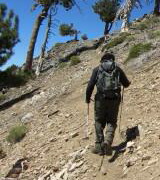 Route conditions — In hiking, you’ve left the world of concrete sidewalks and now you’re in the wild. The most fundamental aspect of safety is concerning the condition of the path you walk and the steps you take. Occasionally I’ll hear on the news of some hiker in our local mountains who has fallen over a steep slope and has to be rescued. I always ask myself, what went wrong? Well, most likely they went over the cliff because they didn’t put their foot in a safe place. You can greatly reduce your chances of becoming a headline if you develop good habits of safety consciousness.
Route conditions — In hiking, you’ve left the world of concrete sidewalks and now you’re in the wild. The most fundamental aspect of safety is concerning the condition of the path you walk and the steps you take. Occasionally I’ll hear on the news of some hiker in our local mountains who has fallen over a steep slope and has to be rescued. I always ask myself, what went wrong? Well, most likely they went over the cliff because they didn’t put their foot in a safe place. You can greatly reduce your chances of becoming a headline if you develop good habits of safety consciousness.
Even before you set out on a hike, find out about the trail. Is it written up in a trail guide? Is it well maintained? Have there been recent weather conditions which might have caused an unsafe condition? Is the trail suited to your skill level and physical condition?
Then once you’ve began the hike, be aware of anything on the trail that could be a potential hazard. That may be stating the obvious, but walking in the wild is different than walking down the street. A root sticking up in the path, a smooth rock covered with a thin layer of lose dirt, a sharp branch sticking out into the trial—all can cause you harm if you are not careful. Watch your footing, particularly near the end of the hike when you’re tired and prone to shuffle your feet. If you’re boulder hopping or crossing a creek, know that unstable or wet rocks can be treacherous. Don’t cut switchbacks—that is, as a trail zigzags up a steep slope, don’t take short cuts. Not only is it unsafe but it causes soil erosion and scars the environment.
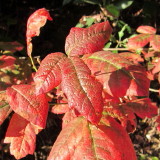
Plant life — If you’ve ever had a bout with poison oak or stinging nettles, you certainly don’t need my lecture on avoiding the stuff. But it’s always amazing to me how many people I run into on the trail who are oblivious to these obnoxious plants. Before you go hiking, learn what plant hazards are found in your area. Know how to identify them, where they grow, and what they’ll to do you if you come in contact with them. And learn how to treat it if you touch them. Also be aware that your dog can get the toxic oil from poison oak or ivy on its fur and transfer it to you! See my posion oak page for lots of pictures and helpful information.
Then there are the plants that are not poisonous, but can puncture you, such as cactus or yucca or types of thorny brush—all the more reason for staying on a well maintained trail.
And while talking about plants, most of us know that there are many eatable plants in the wild. The problem is, there are also many toxic plants as well, and it’s often difficult to tell the difference. So unless you have a reasonable degree of expertise in eatable plants, be safe and avoid eating the vegetation.
Creatures — Dorothy of Oz fame was concerned about the "lions and tiger and bears, oh my!" And often, when we think about creatures that would cause us harm, the big ferocious animals are the ones the come to mind. But in reality, rarely are hikers harmed by these animals. For the most part, bears, mountain lions, and the like tend to stay away from people. But still, be aware of the specific animal population in your area and learn what to do if you encounter a wild animal.
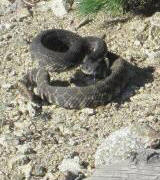
Some of the most menacing creatures are the itty-bitty ones—ants, mosquitoes, ticks, bees, etc. A number of years back a friend of mine was leading a bunch of children on a hike in the forest at summer camp. One of the boys decided to throw a rock into a hollow log. To everyone’s alarm, the log was occupied by a beehive! The bees swarmed and every kid got multiple stings. Even sitting on a comfortable log to have some lunch may find you with ants in your pants. So in the wild, be aware and observant. Make sure you carry a good bug repellant to guard against mosquitoes and pesky bugs (repellent with deet is supposed to be the most effective). In some parts of the country ticks can be a threat, so take care.
And of course there are snakes to think about. I’ve met people who won’t go hiking because they fear snakes. But in general the threat of being bit by a dangerous snake is pretty low, particularly if you are observant. Snakes, as with most wild animals, really don’t want to be around humans. So usually they are as eager to avoid you as you are eager to avoid them. But none the less, learn about the snakes that live in your hiking habitat and be observant of all the safety issues concerning them. Knowledge is a great tool in dispelling unfounded fears and to arm you with the ability to be prepared for real threats.
Some of the most hazardous creatures are the ones you can’t see—the micro-organisms living in water. Invisible pests such as giardia lamblia and cryptosporidium can make you terribly sick with intestinal distress and more. Even when the water looks pure and clean, don’t be deceived, it can be dangerous to your heath if you drink it. The smartest rule is to not drink any untreated water.
So when it comes to creatures big and small, be knowledgeable, be aware, and be observant.
Weather — Check the weather forecast before you hike. How hot will it be? Is there a threat of rain or high winds? What are the extremes in weather conditions where you will be hiking? When is sunset? Do you have the right clothing and protection? Is it indeed safe to go hiking on that day?
 The scariest and most hazardous weather situation I’ve experienced was being caught in a blinding hale storm near the summit of the 11,499-foot Mt. San Gorgonio. And all I was wearing was a t-shirt, light wind-breaker, and shorts! And if being freezing cold wasn’t enough, there was lightning striking all around us causing our hair to stand on end. I lived to tell about it and often look back and ponder how close I was to being a headline. I was young and naïve to the reality that sudden storms can occur at high mountain elevations in certain geographical settings.
The scariest and most hazardous weather situation I’ve experienced was being caught in a blinding hale storm near the summit of the 11,499-foot Mt. San Gorgonio. And all I was wearing was a t-shirt, light wind-breaker, and shorts! And if being freezing cold wasn’t enough, there was lightning striking all around us causing our hair to stand on end. I lived to tell about it and often look back and ponder how close I was to being a headline. I was young and naïve to the reality that sudden storms can occur at high mountain elevations in certain geographical settings.
In the same mountain range nearly 10 years later, on a three-day trek, I had another weather experience. This time it was due to heat, high elevation, and not enough water. Thankfully, I again avoided becoming the top story on the six o’clock news. I’ve learned valuable lessons from both experiences and am much keener as to the ruthlessness of mother nature.
A wise hiker will be aware of weather conditions, the effects of altitude, and the need for plenty of fluid and appropriate clothing and equipment. How much water will you need? Is there water in route? How will you treat it?
When you leave the comfort and safety of civilization and venture into the wild, it can indeed be a wild experience. Know what you’re getting into and be prepared. And as you hike, be observant of the weather conditions and act appropriately before the situation poses a risk.
Human factors — Another area under safety is to be aware of the human factor. First, start with yourself. As you hike, be observant of what your body tells you. Are you getting too hot, cold, tired, hungry, sore? This ties into the weather point but takes it a step further—not only are you constantly observing the weather, you are also monitoring your body’s response to it.
How are your feet? Are there any "hot" spots? Taking care your feet is one of the most crucial parts of a safe, enjoyable hike. Pay attention to your feet and treat potential blisters before they are a problem. I usually carry a spare set of socks and foot powder. In the second half of a long hike, I love to sit down in the shade, take off my footgear, and air out my feet. If there is a stream, cooling the feet is wonderful. I dry them off, apply tape or mole skin as needed, powder them up, put on fresh socks, and strap up the boots. My feet are now ready for many more miles.
And while you’re observing your body, pay attention to the effects of the sun and wind. Take with you a wide brim hat, sunglasses, sun block lotion, and chap stick with sun protection. And use them. If the weather is cool, gloves and a beanie can be a real help. The bottom line, as expressed in the Boy Scout motto, "Be prepared."
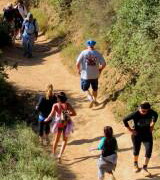 The other part of the human factor is others. It’s always advisable to practice the buddy system. Have a hiking partner or two, and stay together. And as you hike be observant of your partners. How are they doing? Good hiking partners look out for one another.
The other part of the human factor is others. It’s always advisable to practice the buddy system. Have a hiking partner or two, and stay together. And as you hike be observant of your partners. How are they doing? Good hiking partners look out for one another.
Then there is an aspect of the human factor which I don’t particularly want to bring up. Every once in a while there’s a news headline about someone who is harmed on a trail by someone else. It’s a tragedy that some humans wrongfully hurt others. But don’t let that deter you from hiking anymore than hearing of a car jacking should keep you from driving. Know yourself, your area, and the risks, and be smart and observant. Then enjoy yourself!
And while talking about humans, let’s be aware of what humans have built that may be a hazard to the hiker—abandoned mines and buildings, rustic bridges, barbed wire, towers, power transmission equipment, and the like. Observe (in the sense of "obey") posted warning signs. In light of the remoteness of your location, an injury in the backcountry can be much more serious than the same injury at home. So, weigh risks carefully. The key, again, is to be observant and smart.
And before you head out to your adventure, tell another human where you are going and when you will be back.
Equipment — And finally, what to bring is is a vital consideration to observe before you head out on a hike. Having the appropriate clothes, footwear, food, water, the Ten Essentials, and other gear is critical for having a safe, comfortable, and enjoyable outing. Not to be melodramatic, but hikers die for lack of the necessary equipment. Read my Hiking Essentials section on my hiking tips page to learn more about what you need to bring on your hike.
| 2. NAVIGATION |
Next, a skilled hiker is observant in navigation. When I hear a news report of some hiker getting lost, I think, That does not have to be!
The first area in navigation is the preparation. Get information about the trail that you’ll be hiking. Study the map and read the trail description. Know where you’re going.
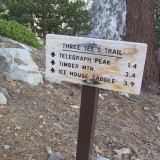
In your planning process, realistically estimate how long it will take to do the hike. A typical walking speed is three miles an hour, or 20 minutes a miles Trail conditions such a steep uphill climb or boulder hoping reduce that time. Be sure to calculate time for breaks. I find that when I reach a mountain summit, I can easily spend an hour soaking in the experience before starting back. So I factor that into my total hike time calculations.
As you hike, be observant for navigation. Watch for trail signs, landmarks, junctions. Be aware of the topography and where you are in the overall scheme of things. Does what you’re seeing match the trail description and maps? Periodically, stop and look at the trail in the opposite direction, becoming familiar with your surroundings from different perspectives.
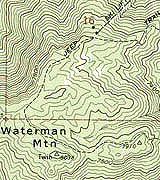 Pay close attention to trial junctions. A junction is a good place to get out your map and trail description to confirm where you are and which direction to take. And check your watch. For example, sometimes there are trail junctions that don’t appear on the map. If your trial description says the first junction of your route is in two miles, and you reach a junction in 20 minutes then you’ll need to figure out what’s amiss (under normal walking conditions you would have only covered about a mile or less in 20 minutes). If you are not conscientiously noting the time on your watch, it’s easy to lose track of time and make errant navigation decisions.
Pay close attention to trial junctions. A junction is a good place to get out your map and trail description to confirm where you are and which direction to take. And check your watch. For example, sometimes there are trail junctions that don’t appear on the map. If your trial description says the first junction of your route is in two miles, and you reach a junction in 20 minutes then you’ll need to figure out what’s amiss (under normal walking conditions you would have only covered about a mile or less in 20 minutes). If you are not conscientiously noting the time on your watch, it’s easy to lose track of time and make errant navigation decisions.
Part of your pre-hike training is to learn what to do if you get lost. Read an article and learn the basics. And carry the right equipment with you such as a whistle; three short blasts is a universally recognized signal for emergency. I always carry a cell phone on my hikes. Even though there are hiking areas where the phone is out of range, a phone is still good to have just in case. Sometimes I carry two-way radios, particularly if I’m with a group of several people and anticipate that we may split up at some point (for example two of us will want to wait at a saddle while the other two climb to the summit).
So, the key to good navigation is being observant. Be aware and alert. Know where you are and where you’re going, and keep mental or written notes of the time.
| 3. APPRECIATION |
Learn to appreciate your environment. This to me is at the heart of hiking. Being observant for safety and navigation are necessary so that you arrive at your destination in one piece. But the real reason you hike is for its qualities of personal enrichment. Have you noticed that some of the happiest people are those who have an attitude of gratitude? They have learned to be truly thankful in all situations.

When I hike, I often find myself pausing and saying something like, "Wow, this is great!"—to which my son or daughter responds, "Dad, you’ve said that a 100 times!" Hiking to me is not about walking along a dirt path. It’s about being in the midst of nature in all its glory and soaking it in.
Appreciation also relates to value and respect. When we appreciate something, we show respect for it and place value in it. Be earth friendly while you hike. Practice low-impact, no-trace outdoors skills (visit the Leave No Trace website to learn the seven principles of outdoor ethics). Keep your dog on a leash (it's the law). Don’t litter—if you bring it in, take it out. Be extremely careful with fire. Never unnecessarily harm other creatures. Teach your kids to love and respect the environment.
Practice being respectful of other parties with whom you share the outdoors. I’m annoyed occasionally by hikers who are oblivious to others and who spoil the solitude of nature with raucous noise. If I hike three miles to a beautiful waterfall, I certainly don’t appreciate the music from a blaring boom-box of a discourteous sunbather. Unfortunately, those who trash our trails, graffiti the rocks, and disturb the peace are not usually the ones who would be reading an article like this.
So, as you hike, be observant for all the things to appreciate. While you’re at it, be thankful for the efforts of those professionals and volunteers who built and maintain the trail you’re walking on. And the next time you pass by a forest information center or ranger station, stop in and say thank you for their service. In the recent weeks vehicles full of firefighters have been driving through my town to and from a bad wildfire. I’ll give them a thumbs up and mouth the words, "thank you." The returned smiles and nodding heads express their thankfulness to be appreciated.
And if you’re a person of faith, express thanks to the Creator for the gift of earth and the opportunity to enjoy it.
| 4. KNOWLEDGE |
The last area for a skilled hiker is being observant for knowledge. What can we learn from being in nature’s wild outdoors? Be a lifelong learner. As you hike, acquire knowledge. Have an inquisitiveness which seeks to learn about the things around you.
The first area of knowledge is to be observant for what you can learn about hiking itself. Each hike should add to your experience and understanding of this great recreational activity. Learn safety and navigation. Learn the skills of how to read a map and use a compass. Maybe jot down some notes of learnings from each outing. How much water do you drink on a seven-mile hike on a hot day? What didn’t you take that you should have? Are there certain trail foods which work best for you? What kind of hikes give you the most satisfaction?
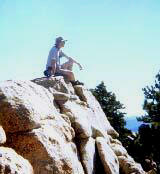
Another area of learning is about the outdoors. What can you learn about plants and animals, rocks and weather, history and geography, forestry and land management? Find an area of interest and began to learn more about that subject each time you go out. For me, I enjoy botany and geology. Plants and rocks fascinate me. So I am constantly learning to identify various flowers and trees and bushes. I learn what species are native and what ones are introduced. Occasionally I even learn the scientific name for a plant. I love pointing to poison oak I saying, "And here we have a fine specimen of Toxicodendron diversilobum." I’ve not studied Latin and am not a botanical expert, but learning is fun and enriching.
When I hike through burned areas I observe the "pioneer plants" that are beginning to emerge to life. I enjoy learning how Native Americans used various plants. I’ve also learned that when my kids hike with me that they don’t share my fascination with vegetation. So I learn to balance my enthusiasm in respect for my hiking partners.
An introductory geology course in college helped me gain an appreciation for rocks. I don’t remember a lot of what I learned those decades ago, but it provided the basic foundations, such as helping me know the difference between igneous, metamorphic, and sedimentary rock, and to be observant of those types when I’m in the field.
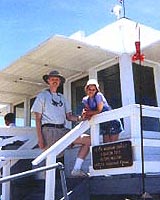 There are so many subjects from which you may find a desire to learn about some. I’ve never really acquired much interest in birds beyond occasionally admiring a hawk souring above or watching a humming bird hovering around a feeder at a fire lookout. But some people get into serious bird watching and love it. Others carry plaster and make casts of animal prints. Some are rock hounds and others can name the various types of clouds overhead. Some hikers are abandoned-mine enthusiasts. I once had a hiking partner who monitored his pulse and kept notes of his heart rate at various elevations—he was fascinated by aerobics. I’ve enjoyed hiking with my young daughter. She would pick up a seed pod and be curious as to what plant it comes from. She would ask why are plants so much thicker on one slope than another, or why the moon was still up in the daytime, or what causes there to be stripes in rocks (Ooo, I get recount some lessons from Geology 101!).
There are so many subjects from which you may find a desire to learn about some. I’ve never really acquired much interest in birds beyond occasionally admiring a hawk souring above or watching a humming bird hovering around a feeder at a fire lookout. But some people get into serious bird watching and love it. Others carry plaster and make casts of animal prints. Some are rock hounds and others can name the various types of clouds overhead. Some hikers are abandoned-mine enthusiasts. I once had a hiking partner who monitored his pulse and kept notes of his heart rate at various elevations—he was fascinated by aerobics. I’ve enjoyed hiking with my young daughter. She would pick up a seed pod and be curious as to what plant it comes from. She would ask why are plants so much thicker on one slope than another, or why the moon was still up in the daytime, or what causes there to be stripes in rocks (Ooo, I get recount some lessons from Geology 101!).
The key to learning is being observant and asking lots of questions. Have an inquiring mind. And, I have to admit that even though I have an insatiable appetite for learning, sometimes when I hike I find my mind needing to just relax and soak in the beauty around me without any cognitive engagement. And that’s okay. Sometimes my need to appreciate is greater than my need to learn. And I learned that while hiking.
So whether you are a trained scientist or a casual observer of nature, be a learner and be enriched by acquiring knowledge about your environment, your
CONCLUSION
Hiking is a wonderful pastime which can enrich your life greatly. Develop skills of observation for safety, navigation, appreciation, and knowledge, and you will have many rewarding miles on the trail. Happy hiking! ![]()
This page was last updated January 30, 2020.
![]()